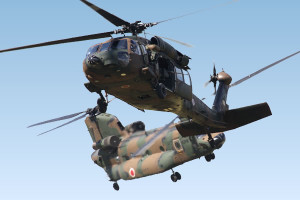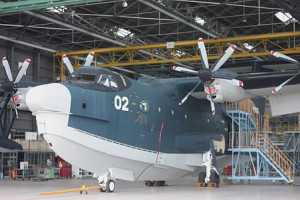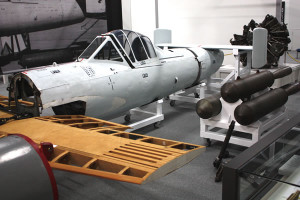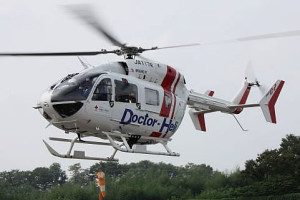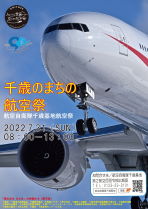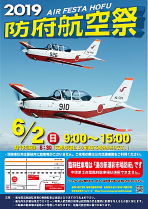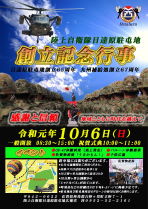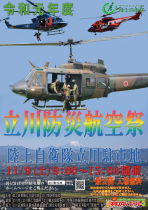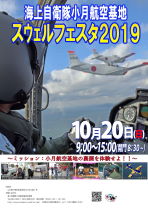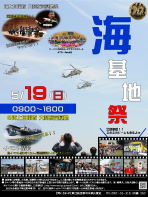JMSDF Squadron Histories & Markings Part 3
Following the pattern of the preceding history pages, the following listing of JMSDF helicopter units appears in numerical order by Fleet Air Squadron (FAS). Note that these do not include entries for the flights into which these squadrons were in some cases divided.
 A 122nd FAS HSS-2B offers a view of its undersides. The sonobuoy launching equipment
A 122nd FAS HSS-2B offers a view of its undersides. The sonobuoy launching equipment
was fitted aft of the radome for the HPS-102 radar, which jutted out more
prominently when deployed. (Photo [undated]: JMSDF)
Fleet Air Squadron (FAS) Listing
| 101st | 111th | 121st | 122nd | 123rd | 124th |
To recap, the relevant fleet air wings (FAWs) were formed as follows:
| 21st FAW | Sept. 1, 1961 (Tateyama) | 22nd FAW | Dec. 1, 1987 (Omura) |
 One of the first generation of minesweeping helicopters to equip the 111th Fleet Air Squadron,
One of the first generation of minesweeping helicopters to equip the 111th Fleet Air Squadron,
a KV-107IIA-3 basks in the sun at its Shimofusa home in July 1978. In the background
are P-2J Turbo-Neptunes then being used in the training role by the
205th Air Training Squadron. (Photo: Kenju Ohmoto)
The six squadrons featured on this page comprise those that operated one or more of the three versions of the HSS-2 Sea King before transitioning to the SH-60J in the 1990s, and the 111th FAS that has itself uniquely flown three types over the years in the minesweeping role.
 (Photo [123rd FAS HSS-2B, Omura, May 1993]: Takao Kadokami)
(Photo [123rd FAS HSS-2B, Omura, May 1993]: Takao Kadokami)
 101st FAS SH-60Js at Tateyama, October 2002
101st FAS SH-60Js at Tateyama, October 2002
 111th FAS at Iwakuni, September 2012
111th FAS at Iwakuni, September 2012
|
101st FAS |
Formed |
(As Tateyama Kōkūtai) Sept. 16, 1953 (As 101st Hikōtai, under Tateyama Kōkūtai) Aug. 5, 1958 (HSS-1) (As 101st Kōkūtai) Sept. 1, 1961 (21st FAW, Tateyama, HSS-1/-1N) |
| Disbanded | March 26, 2008 (Tateyama, merged with 121st and 123rd FASs to form 21st FAS at Tateyama) |
To the 101st FAS fell the responsibility for patrolling and, if the need had arisen, defending Tokyo Bay. Placed in overall command, the Tateyama Kōkūtai was formed on September 16, 1953, and its inauguration marked by a ceremony on December 1 that year. In contrast, for a unit that was to remain in existence in some form or other for around 50 years, the origins of the 101st are not quite so clear-cut.
According to the presumably correct Tateyama website and a panel display in the base museum, a directive for the formation of the then hikōtai-level 101st and other units, including the 102nd and 103rd, came into effect on December 1, 1955; another source gives November 14, 1955. All sources do seem to agree that the 101st, 102nd and 103rd hikōtai were reformed into the 101st, 151st and 152nd hikōtai on August 5, 1958. (Ultimately, the 151st and 152nd hikōtai became the 211th and 221st Air Training Squadron, respectively.)
Key Dates in History of Precursor 101st Hikōtai
Dec. 1, 1955 Formed at Tateyama
Oct. 14, 1957 First mission deployment (emergency airlift of patient from
Miyake Island)
Aug. 16, 1958 Receives first HSS-1
Aug. 31, 1961 Receives first HSS-1N
The extensive reorganization of September 1, 1961, saw the 101st re-designated as a kōkūtai under the 21st Kōkūgun at Tateyama, one of four newly formed fleet air wings, flying four HSS-1s and five HSS-1Ns. (In all, the JMSDF procured a total of 17 of what were the world’s first genuine anti-submarine warfare helicopters, which had been partly financed by the U.S. Navy. The last HSS-1 was decommissioned in March 1975.)
Whereas the HSS-1/-1N operated in pairs as the respective submarine ‘hunter’ and ‘killer’ elements, technological advances—including AN/AP-130 Doppler radar and AN/AQS-10 dipping sonar—and the added power benefits of two T58 turboshaft engines enabled a significant capability upgrade upon the service’s receipt of nine HSS-2s in 1964/65.
Showing the then eagerness of the United States in sharing state-of the-art technology equipment with its ally so soon after its introduction into U.S. Navy service, and the high expectations of the then Japan Defense Agency, the maiden flight of the first Mitsubishi-assembled Sea King had taken place on December 2, 1963, its delivery (to the 51st FAS) on March 24, 1964. In 1965, the first S-61A built for service on board the Antarctic icebreaker Fuji was completed, the aircraft being assigned to and operated by a hikōka (flight), which later also flew Kawasaki-built OH-6Ds, within the 101st. (This sub-unit will be covered separately later.)
Disaster struck on January 16, 1967, when a 101st HSS-2 was involved in what was the type’s first fatal accident, a collision with an 11th FAS Tracker off Tokushima, resulting in the loss of 10 lives.
 A 101st FAS HSS-2A at JASDF Hyakuri AB in July 1985 (Photo: Takao Kadokami)
A 101st FAS HSS-2A at JASDF Hyakuri AB in July 1985 (Photo: Takao Kadokami)
The production run of 55 HSS-2s (equivalent to the U.S. Navy’s SH-3A) was followed by 28 HSS-2As (SH-3D) with upgraded engines and 84 HSS-2Bs (SH-3H) with upgraded radar and ASW systems; the last examples of the three variants were decommissioned in 1986, 1990 and 2004, respectively. It was a 101st HSS-2B (8142) that took the type’s final bow on the Tateyama stage on December 5, 2000.
The return of the Ogasawara (Bonin) Islands in 1969 and Okinawa in 1972 increased the area of ocean under Japanese control, gradually extending operations in which the 101st played a pivotal role. Three 101st HSS-2s were passed on to form the nucleus of the 121st FAS (see later) in February 1973.
 101st FAS pilots taxi their HSS-2B behind the ‘follow me’ jeep after arriving for the JGSDF Kisarazu
101st FAS pilots taxi their HSS-2B behind the ‘follow me’ jeep after arriving for the JGSDF Kisarazu
air show in 1997. The aircraft is fitted with deflectors on the engine intakes to prevent snow and
ice ingestion, which had likely been the cause of two fatal HSS-2 accidents in the 1970s.
(Photo: BANCHOUさん via Twitter @BANF30)
 (Above and below) One of a pair of 101st HSS-2Bs that visited the JASDF Iruma AB show in 1998.
(Above and below) One of a pair of 101st HSS-2Bs that visited the JASDF Iruma AB show in 1998.
 (Photos: しか太郎 [Shikatarō] via Twitter @bsq2lH6s5FlWVh6)
(Photos: しか太郎 [Shikatarō] via Twitter @bsq2lH6s5FlWVh6)
The 101st received its first SH-60J (8262) on July 21, 1998.
101st Kōkūtai HSS-2 Era Events and Snapshots 1964–2000
Mar. 24, 1964 Receives first HSS-2
July 11, 1964 First aircraft at Shin Meiwa Itami plant (link)
Dec. 1964 Third HSS-2 (8003) when undergoing flight tests early in its life,
at Shin Meiwa (now ShinMaywa)’s Itami plant (link)
May 21, 1967 HSS-2 takes part in Armed Forces Day event at Atsugi (link)
(link)
May 1968 HSS-2 8007 at rainy Armed Forces Day event at Atsugi (link)
Oct. 12, 1968 Three HSS-2s take part in international air show at JASDF
Iruma AB (link)
Feb. 20, 1973 121st Hikōtai formed within 101st
Apr. 29, 1973 HSS-2 8002 undergoes maintenance while at JASDF Hyakuri AB
air show (link). Note open nose access door
Aug. 24, 1974 Receives first HSS-2A
Nov. 27, 1974 Detachment of 121st Hikōtai (121st FAS) formed (see later)
May 1980 HSS-2A displayed at JGSDF Tachikawa open day (link)
Sept. 28, 1984 Receives first HSS-2B
Nov. 1985 HSS-2A 8075 performs rescue demo at Tateyama display (link)
July 1, 1989 Receives award from Prime Minister Sōsuke Uno in recognition
of efforts in airlifting emergency cases from remote islands
May 20, 1991 HSS-2B 8125 at Tateyama (link)
June 18, 1993 900th emergency/disaster relief mission deployment
Jan.1995 Disaster relief deployment in aftermath of Hanshin (Kobe)
Earthquake
Mar. 1995 1,000th emergency/disaster relief mission deployment
June 9, 1995 Receives award from Tokyo Governor Yukio Aoshima in
recognition of efforts in airlifting emergency cases
Sept. 1996 HSS-2B 8130 at Yokota AB (link)
Oct. 1, 1996 1,100th emergency/disaster relief mission deployment
July 17, 1998 Becomes first land-based unit to receive SH-60J
Oct. 2000 A weather-beaten 101st FAS HSS-2B (link), two months before
the curtain came down on the type’s service career.
Dec. 1, 2007 SH-60J 8229 photographed four months before the unit’s
disbandment (link).
Undated YouTube footage exists of a possibly 101st FAS but almost certainly Tateyama-based HSS-2B (8150) landing at JGSDF Kasumigaura (link).
 Pre-flight preparations on a busy 101st Sqn ramp at Tateyama, October 2002
Pre-flight preparations on a busy 101st Sqn ramp at Tateyama, October 2002
The 101st’s existence came to an end with the major organizational shakeup that the JMSDF’s sea and air elements underwent in March 2008. In the case of the helicopter squadrons, the squadrons with three-digit unit numbers were disbanded and two-flight patrol helicopter squadrons with two-digit numbers activated, bringing them more into line with the numbers of their respective air wings.
101st FAS Accident Record
Jan. 16, 1967 (HSS-2 8008) Mid-air collision with S2F-1 off Tokushima (total of 10K*)
Oct. 5, 1967 (HSS-2 8013) Forced to ditch close to Oshima, one of the Izu-Oshima islands, when heading to airlift pick up patient. Aircraft sank, all five crew members sustain injuries but are rescued
Dec. 25, 1968 (HSS-2 8021) Came down in Sagami Bay, about 20km off Jogashima, Kanagawa Prefecture. Aircraft sank, crew of four rescued
Aug. 7, 1975 (HSS-2 8005) Transmission failure on flight training, crash landed and sank east of Cape Inubo, Chiba Prefecture
May 24, 1979 (HSS-2A 8070) Crashed and sank 50 km east of Choshi, Chiba Prefecture, on way to participate in nighttime anti-submarine training (1K)
(* Indicates number of crew members killed in line of duty)
101st FAS Markings
In the early period of its HSS-2 operations, the 101st flew aircraft not only in standard Insignia White and Aircraft Gray but also in Dark Seaplane Grey overall with dayglo areas like the S-61As, as seen at a rainy Atsugi in May 1968 (link) and on a pair of aircraft at Iruma in October the same year (link); note the triangular squadron marking on the outside of their sponsons. (See following for colour photo of 101st FAS marking.)
(HSS-2, 1960s) A triangular, stylized orange and yellow ‘101’ carried on the sides of both sponsons, as seen here in this photo taken at JASDF Hyakuri AB in 1968 (link)
(SH-60J) Not known for their colourful identification markings, 101st FAS aircraft simply carried the number 101 in black above the serial numbers on their tails.
|
111th FAS Griffin |
Formed | Feb. 16, 1974 (under direct FAF command, Shimofusa, KV-107) |
| Current Base | Iwakuni (still under direct FAF command, MCH-101) |
Two KV-107II-3s had been funded under the 1961 fiscal year budget and handed over on September 16, 1963, for evaluation in the minesweeping role. The first of a type that saw service with all three branches of the SDF, a lack of funds and a protracted test programme delayed the formation of a specialized JMSDF squadron for more than a decade.
When finally established, the 111th FAS was equipped with nine aircraft, the first two of which were the by then already advancing in years KV-107II-3s that had been undergoing test and evaluation by the 51st FAS at the same base of Shimofusa up to 1971; acquired between 1972 and 1976, the remainder were -3As with uprated engines.
 Airborne from Shimofusa, a lone 111th FAS KV-1017II-3A over the Chiba countryside and here
Airborne from Shimofusa, a lone 111th FAS KV-1017II-3A over the Chiba countryside and here
(link) in colour at its home base in March 1984 (Photo [undated]: JMSDF via Wikimedia Commons)
 Long before the advent of automated spray systems built into airfield taxiways, JMSDF
Long before the advent of automated spray systems built into airfield taxiways, JMSDF
personnel had no choice but to resort to the Mk.1 garden hose to wash off salt deposits
after flights. The airfield elevation of 98 feet pinpoints the location of this tranquil scene
as, not surprisingly, Shimofusa. (Photo [undated]: JMSDF 111th Flight Squadron)
This photo (link) shows preparations for the traditional first flight of the New Year in January 1985, when all nine aircraft took to the air. The photographer states that he was then living in the northeast of Chiba Prefecture, and pairs of KVs heading out and returning from training over the Pacific were a common sight. Two other photos show aircraft at the Shimofusa air shows in May 1979 (link) and May 1986 (link).
 Also capable of refueling while in the hover, a KV-107II undergoes replenishment at sea while on the
Also capable of refueling while in the hover, a KV-107II undergoes replenishment at sea while on the
deck of the Hayase. Serving primarily in the minesweeping tender role from 1971 to 2002, this
ship was deployed to the Persian Gulf in the aftermath of the Gulf War in 1991 to clear mines
that had been laid by Iraqi forces. (Photo [undated]: JMSDF 111th Flight Squadron)
Aside from their primary task, the helicopters were used for the airlift of the equipment necessary for minesweeping and communications and, for example, the laying of fences to contain oil slicks. The crews normally comprised a total of six: two pilots and a flight engineer on the flight deck; an on-board technician in charge of navigation, communications and the monitoring of systems from a station on the left side, aft of the cockpit; and two airborne ordnance crew members/loadmasters handling the minesweeping equipment at the rear.
 (Above and below) The eighth of the nine JMSDF KV-107IIs when on visits to Atsugi on New Year’s
(Above and below) The eighth of the nine JMSDF KV-107IIs when on visits to Atsugi on New Year’s
Day 1979 and to Kanoya in April 1990. Initially operated by the 51st FAS test unit (q.v.), the first
two aircraft had been painted Engine Gray overall, and it was only in the late 1960s that the
upper surfaces were painted white, like on the UF-2s and Neptunes, in a
bid to reduce the temperature inside the aircraft.
 (Photos: [top] U.S. National Archives/U.S. Navy PH3 Brian Cahill; [above] Takao Kadokami)
(Photos: [top] U.S. National Archives/U.S. Navy PH3 Brian Cahill; [above] Takao Kadokami)
According to the Iwakuni website chronology, the unit moved from Shimofusa to its long-standing Iwakuni base in September 1, 1989, when by then only two KVs remained in service.
The decision to introduce MH-53Es as successors to the KVs having been taken in 1986, the first arrived for testing on March 30, 1990, and entered service that November. The type was referred to as the Super Stallion in JMSDF service.
From those humble and protracted beginnings, Japan went on to adopt four minesweeping methods to equip the KV-107 and MH-53E for the potentially vital role of protecting its sea lanes: the MK-101 mechanical minesweeping gear, MK-103 mechanical system and the sled-mounted MK-104 acoustic and MK-105 magnetic systems. These were all originally developed for the U.S. Navy by the long-established Panama City Division of the Naval Surface Warfare Center—and latterly for the most part built by the now defunct ITT Exelis company—but nowadays only the MK-104 acoustic minesweeping system remains in service.
June 6, 1995, was a tragic day for the 111th FAS. Operating from Shimofusa, a fire broke out on board MH-53E 8626 when one of a pair conducting minesweeping training at a height of 50 metres over Sagami Bay, off Kanagawa Prefecture. The aircraft sank after ditching, and the accident claimed the lives of all eight crew members. The cause of the fire was an overheating swashplate, the device that translates inputs from the flight controls into the motions of its main rotor blades; the May 1996 crash of a CH-53 in the United States was to provide the evidence.
On a happier note, an event was held to mark the unit’s 30th anniversary on March 13, 2004. The first of the MCH-101s was received on March 25, 2008, but it was not until March 3, 2017, that the decommissioning ceremony for the veteran MH-53s was held. (See the Bulletin Board story for March 3, 2017, and the JMSDF Where Are They Now? section on the Sikorsky MH-53E.)
 U.S. Navy personnel hasten to secure 8625 on the deck of the amphibious dock landing ship
U.S. Navy personnel hasten to secure 8625 on the deck of the amphibious dock landing ship
USS Tortuga (LSD 46) in the Philippine Sea during the bilateral Annual Exercise 2011.
(Photo [October 2011]: U.S. Navy/Lt. Colby Drake via Wikimedia Commons)
 The old guard and the new at Iwakuni, September 2012. Two other aircraft took a somewhat
The old guard and the new at Iwakuni, September 2012. Two other aircraft took a somewhat
more active part in events that day, and video of them was posted on YouTube (link).
 (Photos: J-HangarSpace)
(Photos: J-HangarSpace)
 MH-53E 8625 is put through its paces at Iwakuni on Valentine’s Day 2017. This aircraft completed
MH-53E 8625 is put through its paces at Iwakuni on Valentine’s Day 2017. This aircraft completed
the type’s very last flight three days later and was one of two feted at a decommissioning ceremony
just two week weeks after that, on March 3, 2017. (Photo: vx51 via Twitter @vx51)
YouTube footage (link) also exists of the aircraft on February 14, 2017.
 The 111th’s representative impressively flies the flag for the unit at the Tateyama Helicopter Festival
The 111th’s representative impressively flies the flag for the unit at the Tateyama Helicopter Festival
in October 2013. The other aircraft seen in showroom condition at the decommissioning ceremony,
8631 was one of the seven that were sent back to the United States for the reclamation of parts. (See
the JMSDF Where Are They Now? page.) In contrast to their pristine appearance at the ceremony
(below), 8625 and 8631 were seen still on their undercarriages but in a sadly stripped-down
state at MCAS Miramar, California, in January 2021. (Photo: Akira Watanabe)
 As the type was often to be seen in a rather sooty state, MH-53E 8625 would likely have needed a
As the type was often to be seen in a rather sooty state, MH-53E 8625 would likely have needed a
lot of painstaking cleaning in preparation for the closing ceremony of its career. This photograph
was taken in its gainfully employed days at Iwakuni in September 2012. Known as an aperture
guard, the bar structure extending from the rear of the aircraft prevented the rope fed out
from the minesweeping equipment drum from coming into contact with the aircraft.
 (Above and below) Scenes at Iwakuni on March 3, 2017, when the 111th FAS officially dispensed
(Above and below) Scenes at Iwakuni on March 3, 2017, when the 111th FAS officially dispensed
with the services of and bade farewell to its MH-53E fleet, 29 years after the delivery of the first
aircraft. The unit’s CO, Capt. Motoi Haga, received a commemorative plaque from a senior
Sikorsky Aircraft executive in recognition of the average of 6,000 hours flown by the
aircraft in 27 years of squadron service.
 (Photos: U.S. Marine Corps Air Station Iwakuni/Lance Cpl Joseph Abrego)
(Photos: U.S. Marine Corps Air Station Iwakuni/Lance Cpl Joseph Abrego)
Snapshots of 111th FAS MCH-101 Operations
Derived from the AgustaWestland (now Leonardo) EH-101 and flown for the first time in the UK on February 15, 2005, the imported first MCH-101 arrived at Kawasaki’s Gifu Plant on July 25 that year and was delivered on March 3, 2006. Tested by an Iwakuni-based detachment of the 51st FAS, the type was cleared for squadron operations on March 30, 2007, but was not received into service by the 111th FAS until March 25, 2008.
In the meantime, the second, Kawasaki-assembled aircraft (above) had been handed over to the JMSDF on March 23, 2007. Sighted in 51st FAS markings at Nagoya in January 2017 (link), the 10th and last of the MCH-101 order (8660) was delivered initially to Gifu for testing in March 2017 and placed in squadron service at Iwakuni by May that year.
The first MCH-101 to be fitted with the latest equipment for the integrated airborne mine countermeasures (AMCM) role, as opposed to being used to tow systems, 8656 was handed over to the JMSDF at a ceremony held at prime contractor/systems integrator Kawasaki’s Gifu plant on February 27, 2015; its test programme lasted until the following year.
Aside from occasions when the unit has been drafted in to help in disaster relief airlift missions, the 111th’s year is taken up with training, such as qualifying pilots to carry out deck landings, and participation in exercises. The latter are most often conducted with the U.S. Navy, along with the U.S. Marine Corps the only other air arm that utilizes helicopters in the AMCM role. Every year, like the MH-53Es before them, up to three MCH-101s are deployed to Ohminato, Aomori Prefecture, to conduct training in Mutsu Bay with the local JMSDF flotilla.
 Training underway with the minesweeper tender Bungo in attendance (Photo: JMSDF)
Training underway with the minesweeper tender Bungo in attendance (Photo: JMSDF)
 A long way from home, two 111th FAS MCH-101s aircraft make a refueling stop at the airport on
A long way from home, two 111th FAS MCH-101s aircraft make a refueling stop at the airport on
Hachijojima, a Tokyo-administered volcanic island strictly speaking in the Philippines Sea,
around 180 miles (290 km) south of the capital. The aircraft furthest from the camera is
8660, the last of the so far 10 delivered.
(Photo [June 24, 2018]: 帝釈天/八丈島 via Twitter @k19ch1)
Nov. 18–28, 2018 Mine warfare training/minesweeping special training, Hyuga-nada Sea
A total of 22 JMSDF vessels, including the minesweeper tender Bungo, conducted training with a U.S. Navy ship and two from Royal Australian Navy in the northwestern Pacific Ocean, off the east coast of Kyushu. Up to three MCH-101s were operated in conjunction with U.S. Navy MH-53Es.
 An MCH-101 winches up a diver during a training exercise. Not given a name,
An MCH-101 winches up a diver during a training exercise. Not given a name,
the small vessel in the background is the diving tender YDT-03. (Photo: JMSDF)
Feb. 1–10, 2019 Mines warfare training, Ise Bay
Designed to improve tactical skills, this training involved a total of 16 JMSDF vessels, including both Uraga-class minesweeper tenders, up to two MCH-101s and a total of around 800 personnel.
Feb. 13–22, 2019 Joint anti-submarine warfare training off Shikoku
A total of five JMSDF vessels, including the helicopter carrier Ise, and five submarines took part in what was the 130th time this training exercise with U.S. Navy elements had been carried out since 1957. MCH-101s were among the total of 11 helicopters that were operated from the Ise.
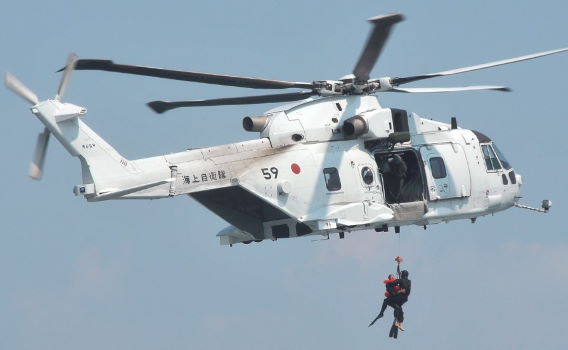 A 111th FAS MCH-101 crew practices overwater hoist procedures. The photo was taken during five days
A 111th FAS MCH-101 crew practices overwater hoist procedures. The photo was taken during five days
of extensive air- and ground-based lifesaving training activities that were held at the
unit’s home base from late in July 2019. (Photo: JMSDF Iwakuni)
Nov. 18–28, 2019 Mine warfare training, Hyuga-nada Sea
Involving around 1,000 JMSDF personnel, this training brought together a total of 17 vessels and was supported by up to three MCH-101s.
Nov. 18–28, 2019 Tripartite minelaying training
Aside from around 1,000 personnel, the JMSDF contribution to this exercise was a total of 17 vessels and up to three MCH-101s. The training was conducted jointly with elements from the U.S. Navy, which provided a minesweeper and two MH-53Es, and two minesweepers from the Royal Australian Navy.
 A 111th FAS MCH-101 participates in an exercise involving helocasting, the use of a helicopter for
A 111th FAS MCH-101 participates in an exercise involving helocasting, the use of a helicopter for
the maritime insertion of a small special operations unit into a specific area. (Photo: JMSDF)
Feb. 1–10, 2021 Minesweeping Training, Ise Bay
The 111th provided the three MCH-101s that joined a total of 16 vessels involved in joint mine warfare and minesweeping training with the U.S. Navy in Ise Bay, off Mie and Aichi prefectures. Previously, this training had been conducted at night, but on this occasion was conducted during the day.
In late February 2021, Leonardo Helicopters announced that the JMSDF’s MCH/CH-101 fleet, for which Kawasaki remains responsible for maintenance and spares support, had amassed a total of 25,000 flight hours.
JMSDF Helicopter Minesweeping Through the Years
 For its unique role within the JMSDF, the 111th started out in the 1960s with the then cutting-edge
For its unique role within the JMSDF, the 111th started out in the 1960s with the then cutting-edge
MK-101 mechanical minesweeping gear shown here. The unit progressed in the late 1960s to the
MK-103 development, which remained in service until 2017. (Photo: JMSDF/111th Flight Squadron)
 Seemingly with a seagull escort, an MH-53E tows a hydrofoil sled-mounted MK-105 mine clearance
Seemingly with a seagull escort, an MH-53E tows a hydrofoil sled-mounted MK-105 mine clearance
system. This helicopter type had been equipped for the full gamut of minesweeping systems, from the
MK-101 to the MK-105, and the latter also followed the aircraft into retirement in 2017.
(Photo: Seagull-jap via Twitter @miejapan4)
 An MH-53E reels in MK-101 mechanical minesweeping gear.
An MH-53E reels in MK-101 mechanical minesweeping gear.
(Photo: Japan Ministry of Defense/JMSDF)
 The crew of an MCH-101, the JMSDF’s third-generation minesweeping helicopter, deploys its
The crew of an MCH-101, the JMSDF’s third-generation minesweeping helicopter, deploys its
Northrop Grumman AN/AQS-24A airborne mine-hunting system. Also equipped with the same
company’s AN/AES-1 airborne laser mine-detection system (ALMDS), publicity material
trumpeted the aircraft’s surface to seabed detection capability. (Photo: JMSDF Iwakuni)
 Referred to in one old JMSDF reference source as a venturi minesweeping system, the MK-104
Referred to in one old JMSDF reference source as a venturi minesweeping system, the MK-104
acoustic system remains in service, having equipped all three JMSDF minesweeping helicopter
types. Prior to the MK-105’s retirement, it had been possible to use the acoustic and
magnetic systems in combination as the MK-106.
(Photo [Iwakuni, May 2015]: Hunini via Wikimedia Commons)
 Iwakuni, May 2017. The old-style MK-104 equipment installed in the last MCH-101 8660,
Iwakuni, May 2017. The old-style MK-104 equipment installed in the last MCH-101 8660,
which had then only recently entered service. (Photo: piromy via Twitter@piromy)
Special Markings
 Usually just limited to national markings and a 111 on the tail, a grimy MH-53E sports a JASDF
Usually just limited to national markings and a 111 on the tail, a grimy MH-53E sports a JASDF
5th Air Wing marking at the Nyutabaru air show in December 2003. (Photo: Takao Kadokami)
In October 2003, 8621 was a guest at an event at the Ozuki pilot training base. At that time it had been used to convey the messages “Good Luck – Fly Young People!!” in English and Japanese, respectively, via its right sponson (link).
 Again unusually, one of the MH-53Es at Iwakuni in July 2005 was decorated with a large marking
Again unusually, one of the MH-53Es at Iwakuni in July 2005 was decorated with a large marking
of a griffin, the 111th’s radio call sign, and a row of six mission marks beneath the cockpit side
window. Dating back to its Shimofusa era, the unit’s KV-107 call sign was Egret.
(Photo: Seagull-jap via Twitter @miejapan4)
In the latter half of 2011, the year of the Great East Japan Earthquake, it was thought acceptable to allow SDF bases to once again open their doors for a day to the public, and at that time some aircraft served as billboards by which to provide messages of encouragement. Next to another variation on the griffin theme, MH-53E 8621 flew at Iwakuni in September 2011 (link) to parade the Gambarō Nippon (‘Hang in there Japan’) message then in vogue. Below that was written a slogan in Japanese (link), meaning Revive that sea, that sky, that land, which was directed at helping those in the tsunami-affected areas of the Tohoku region.
At that same 2011 event, two other aircraft carried the same slogans but with different, black designs. In the case of 8623, the design also featured the vertically written kanji for Tohoku Spirit (link), while 8629 sported the kanji for ‘minesweeping spirit’ and a griffin incorporating ONEELEVEN (link), the lettering of which was reversed on the right-hand side (link).
 Silhouetted on the deck of a ship in Ise Bay is one of the three MCH-101s that took part in a
Silhouetted on the deck of a ship in Ise Bay is one of the three MCH-101s that took part in a
10-day minesweeping training exercise alongside U.S. Navy elements in February 2020.
(Photo: Japan Ministry of Defense/JMSDF)
|
121st FAS |
Formed | (As 121st Hikōtai)
Feb. 28, 1973 (within 101st FAS, HSS-2) (As 121st Kōkūtai) Nov. 27, 1974 (21st FAW, Tateyama, HSS-2) |
| Disbanded | March 26, 2008 (Tateyama, merged with 101st and 123rd FASs to form 21st FAS at Tateyama) |
 Helicopters provided by the 121st FAS were operated from the destroyers Hatsuyuki (DD-122) and
Helicopters provided by the 121st FAS were operated from the destroyers Hatsuyuki (DD-122) and
Shirayuki (DD-123). Both ships were homeported in Yokosuka during their active service,
which ran from 1982 to the 2010s. (Photo: JMSDF)
Its nucleus originally formed as a hikōtai with three HSS-2s on detachment from the 101st FAS for service aboard the destroyer Haruna in February 1973, the 121st’s complement was doubled to six HSS-2A when upgraded to kōkūtai status in November the following year. Initially its personnel totaled 73, under Commander Isao Higuchi. Shore-based at Tateyama, the unit’s aircraft were scattered among the vessels of the JMSDF flotilla homeported in Yokosuka. At the time of the changeover from the HSS-2B to the SH-60J from 1991, the 51st FAS assumed responsibility for the transition training of land-based unit crews but the 121st’s experience dictated that the unit train the crews from shipborne units.
 (Photo: JMSDF Air Training Command via Twitter jmsdf@atrc)
(Photo: JMSDF Air Training Command via Twitter jmsdf@atrc)
121st FAS HSS-2 Era Events and Snapshots (1974–1992)
Nov. 27, 1974 Forms with six HSS-2As
July 1976 HSS-2A 8063 with the Hiei during fleet review (link)
June to Aug. 1978 Three aircraft deployed on training to United States
Jan. to Apr. 1980 Three aircraft deployed on training to United States
Dec. 19, 1980 Receives first HSS-2B (8090)
Feb. to May 1982 Three aircraft participate in RIMPAC 1982
Oct. to Dec. 1982 Three aircraft deployed on training to United States
June to Aug. 1983 One aircraft deployed on training to United States
Apr. to July 1984 One aircraft participates in RIMPAC 1984
June to Aug. 1984 Three aircraft on high seas training sail
(Guam, Philippines area)
Nov. 1984 Fleet review
Apr. to July 1985 Four aircraft deployed on training to United States
 (Above and below) July 26, 1985. Comprising at least two aircraft from the 121st FAS, a line astern formation of five HSS-2Bs conducts display flight training in Sagami Bay prior to that year’s fleet review. They had been launched from ships that included the destroyers Hiei and (right) Hatsuyuki.
(Above and below) July 26, 1985. Comprising at least two aircraft from the 121st FAS, a line astern formation of five HSS-2Bs conducts display flight training in Sagami Bay prior to that year’s fleet review. They had been launched from ships that included the destroyers Hiei and (right) Hatsuyuki. (Photo:ウィングトレイン [‘Wingtrain’] via Twitter @VDu2pZurkPQPEyj)
(Photo:ウィングトレイン [‘Wingtrain’] via Twitter @VDu2pZurkPQPEyj)
Apr. to July 1986 Three aircraft participate in RIMPAC 1986
June to Aug. 1986 Three aircraft on high seas training sail
(Guam, Philippines area)
June to Aug. 1987 Four aircraft deployed on training to United States
July 1987 Three aircraft on high seas training sail
(Guam, Philippines area)
Apr. to July 1988 Seven aircraft participate in RIMPAC 1988
June to Nov. 1989 One aircraft on high seas training sail
(South America)
June to Sept. 1991 One aircraft deployed on training to United States
June to Aug. 1991 Six aircraft on high seas training sail
(Guam, Philippines area)
Feb. 7–13, 1992 Last on-board deployment of HSS-2B
(8096 on Shirane)
Mar. 2, 1992 Last HSS-2B passed to 124th FAS (later 123rd FAS)
Then assigned to the 121st, HSS-2B 8103 was photographed at Nagoya Airport in November 1991 (link).
 Inside the cockpit of a 121st FAS HSS-2B, identified by the Scray Flight patch on the sleeve of pilot’s
Inside the cockpit of a 121st FAS HSS-2B, identified by the Scray Flight patch on the sleeve of pilot’s
flight suit. An obsolete English word for the bird nowadays known as the common tern, scray had
somehow come to be adopted as the 121st’s radio call sign. (Photo [circa 1990]: JMSDF)
 From the outside perspective, a 121st FAS HSS-2B hovers above the deck of an unidentified
From the outside perspective, a 121st FAS HSS-2B hovers above the deck of an unidentified
ship as the JDS Shirayuki (DD-123) passes astern. (Photo [late 1980s]: JMSDF)
121st FAS HSS-2 Accident Record
Oct. 5, 1977 (HSS-2As 8058 and 8059) Collided in mid-air over Chiba Prefecture and crash-landed
May 24, 1979 (HSS-2A 8070) Crashed into sea 50km off Choshi, Chiba Prefecture
Mar. 19, 1980 (HSS-2A 8060) On-board fire broke out when returning in early evening from training, ditched and sank off Cape Suno, Chiba Prefecture. All four crew members injured but rescued
Mar. 27, 1986 (HSS-2B 8100) Crashed off Omaezaki, Shizuoka Prefecture, during training (3K)
June 11, 1988 (HSS-2B 8094) Ditched and sank off Midway Island while assigned to the Shirane during that year’s RIMPAC exercise
JS Shirane (DD-143) Oita Port Visit, August 11, 1989
The first of the class of two helicopter-carrying destroyers to which she lent her name, the Shirane was launched in September 1978 and commissioned in March 1980 to complement and eventually replace the two Haruna-class vessels. Both classes of ship were equipped with a central hangar capable of accommodating up to three helicopters and an extensive stern helideck.
 A fair proportion of the training in these squadrons would have been devoted to keeping pilots
A fair proportion of the training in these squadrons would have been devoted to keeping pilots
qualified in the demanding task of operating from narrow, pitching decks on the high seas.
(Photo: Takao Kadokami)
Although normally homeported in Yokosuka, the Shirane paid a visit to Oita in August 1989, at which time her three 121st FAS HSS-2B helicopters were still embarked.
Naturally progressing to the carrying of SH-60J and ’K helicopters, the Shirane was herself superseded by the Izumo-class of dedicated helicopter carriers and decommissioned in March 2015.
**********************************
121st FAS SH-60J Era Events and Snapshots (1991–2002)
The 121st was the first unit to receive the SH-60J, 8207 arriving as the first on September 30, 1991. The standard squadron complement was 12 to allow one to be deployed on board each of a flotilla’s eight ships with at any given time four on shore either as replacements or undergoing maintenance.
 (Photo [Omura, May 1992]: Takao Kadokami)
(Photo [Omura, May 1992]: Takao Kadokami)
Sept. 30, 1991 Holds ceremony to mark receipt of first SH-60J (8207)
Oct. 1992 Fleet review (five aircraft)
June to Sept. 1993 Three aircraft deployed on training to United States
Apr. to July 1994 Three aircraft participate in RIMPAC 1994
Jan. 1995 Four aircraft deployed on disaster in aftermath of
Hanshin (Kobe) Earthquake
June to Aug. 1995 Three aircraft on high seas training sail
(Guam, Philippines area)
Apr. 1996 Goodwill visit to Canadian Armed Forces’ Maritime
Command (three aircraft)
May to Aug. 1996 Three aircraft participate in RIMPAC 1996
Jan. 1997 Deployed to assist in efforts to contain oil spill from
wrecked Russian tanker Nakhodka off
Shimane Prefecture
Feb. 1997 Assisted in rescue operation involving vessel
used by Chinese smugglers (one aircraft)
July 1997 Containment of oil slick from Diamond Grace
in Tokyo Bay
May 1998 Goodwill visit to Canadian Armed Forces’ Maritime
Command (two aircraft)
June to Sept. 1998 Five aircraft participate in RIMPAC 1998
Oct. 1998 Goodwill visit to Royal Australian Navy (two aircraft)
Dec. 1998 Goodwill visit to South Korean Navy (one aircraft)
May to Aug. 1999 One aircraft deployed on training to United States
Aug. 1999 Three aircraft deployed on Japan-South Korea
joint training
Sept. 1999 Goodwill visit to Russian Navy (one aircraft)
Apr. to Sept. 2000 One aircraft on round-the-world high seas training sail
May to Aug. 2000 Two aircraft participate in RIMPAC 2000
Feb. to Mar. 2001 One aircraft on high seas training sail in Japanese waters
June to Aug. 2002 Two aircraft participate in RIMPAC 2002
Sept. 2007 Standard aircraft, six months before disbandment (link)
 (Photo: Japan Ministry of Defense/JMSDF)
(Photo: Japan Ministry of Defense/JMSDF)
The 121st is known to have been suffered in one fatal SH-60J accident. On July 4, 1995, while being operated from the Shirayuki, SH-60J 8241’s sonar cable unwound unexpectedly four nautical miles northeast of Cape Erimo, Hokkaido Prefecture, and the aircraft rolled over and plunged into the sea. The aircraft’s captain lost his life in the accident, the cause of which was attributed to spatial disorientation.
 On the other side of the world, a 121st FAS SH-60J was on board JDS Yūgiri (DD-153) when the
On the other side of the world, a 121st FAS SH-60J was on board JDS Yūgiri (DD-153) when the
ship paid a visit to Amsterdam in June 2000. (Photo: Rob Schleiffert via Wikimedia Commons)
 Found inside a hangar at Tateyama, October 2002.
Found inside a hangar at Tateyama, October 2002.
 A 121st FAS SH-60J helicopter departs the flight deck of the Nimitz-class aircraft carrier
A 121st FAS SH-60J helicopter departs the flight deck of the Nimitz-class aircraft carrier
USS Abraham Lincoln during an officer exchange in the Western Pacific in March 2006.
(Photo: U.S. Navy/Photographer’s Mate Airman James R. Evans)
 Meanwhile, back in Japan, SH-60J was on board the Amagiri (DD-154) in the
Meanwhile, back in Japan, SH-60J was on board the Amagiri (DD-154) in the
Port of Nagoya, also in March 2006. (Photo via Wikimedia Commons)
 Then assigned to the now decommissioned destroyer Kurama (DDH-144), a 121st SH-60J prepares
Then assigned to the now decommissioned destroyer Kurama (DDH-144), a 121st SH-60J prepares
to land aboard the U.S. Navy carrier Kitty Hawk (CV-63) during the bilateral Exercise
ANNUALEX in mid-November 2006. (Photo: U.S. National Archives/U.S. Navy
Mass Communication Specialist 3rd Class Jarod R. Hodge)
 Operating from the JDS Haruna (DDH-141) in the Philippine Sea in March 2007, a 121st FAS
Operating from the JDS Haruna (DDH-141) in the Philippine Sea in March 2007, a 121st FAS
SH-60J approaches the deck on the guided missile destroyer USS Russell (DDG-59)
during a three-day joint exercise.
(Photo: U.S. Navy/Gas Turbine System Technician [Mechanical] Fireman Derek Webster)
121st FAS Markings
(HSS-2, SH-60J) From front, two red (thick and thin) and two blue (thin and thick) fuselage bands, denoting 121, as seen on this trio of HSS-2Bs at the Tateyama open day in November 1985 (link) and this SH-60J at Kisarazu in October 1998 (link). The practice of wearing these identification stripes was carried on by the 121st to 124th FASs upon their re-equipment with SH-60Js but fell into disuse fairly soon thereafter.
121st FAS Special Markings
May 1997 Harumi Wharf, Port of Tokyo SH-60J 8243 (link)
The fuselage side panel where the sonobuoy launchers are housed has been a favoured “canvas” for artwork among SH-60J units. This design featured the legendary outlaw figure Ishikawa Goemon (1558–1594), who was like a Japanese Robin Hood in that he stole from the rich to give to the poor. Here, somewhat anachronistically, he is depicted trampling on a submarine.
October 2002 JMSDF 50th Anniversary, Tateyama SH-60J 8210
 Note the JMSDF 50th anniversary marking to the left of the hinomaru national marking.
Note the JMSDF 50th anniversary marking to the left of the hinomaru national marking.
 The playful dolphin sticker theme was repeated on the right-hand side.
The playful dolphin sticker theme was repeated on the right-hand side.
 Taken from publicity material, the JMSDF 50th anniversary
Taken from publicity material, the JMSDF 50th anniversary
logo applied to SH-60J 8210 in its printed form.
 A seal balancing a ball, marked with two stars that possibly denoted ‘rear admiral on board’,
A seal balancing a ball, marked with two stars that possibly denoted ‘rear admiral on board’,
adorned the nose.
For comparison, other photos of the right and left side of the above strictly static display aircraft can be found here (link) and here (link), respectively. Although taken on the same day, note that in these photos the anniversary marking on the sonobuoy cover has been replaced with a Scray Flight design incorporating the 121st’s former stripe marking and the two kanji meaning loyalty (link).
 JDS Shirayuki (DD-123) with 121st FAS HSS-2B (Photo: Japan Ministry of Defense/JMSDF)
JDS Shirayuki (DD-123) with 121st FAS HSS-2B (Photo: Japan Ministry of Defense/JMSDF)
|
122nd FAS |
Formed | Mar. 27, 1981 (21st FAW, Omura, HSS-2A/B) |
| Disbanded | March 26, 2008 (Tateyama, merged with 124th FAS and Omura Kōkūtai to form 22nd FAS at Omura) |
Initially formed under the Tateyama-headquartered 21st FAW, the 122nd FAS’s served as the 121st’s counterpart in western Japan. This unit was thus primarily charged with providing ASW helicopters for and, to use the well-worn expression, acting as the eyes and the ears of the JMSDF Escort Flotilla 2 homeported in Sasebo, Nagasaki Prefecture, and Yokosuka, Kanagawa Prefecture.
The 122nd is known to have suffered the loss of one Sea King, when HSS-2B 8098 crash landed in a forest in Mie Prefecture on March 4, 1983.
 JDS Matsuyuki (DD-130), complete with a 122nd FAS HSS-2B
JDS Matsuyuki (DD-130), complete with a 122nd FAS HSS-2B
(Photo: Japan Ministry of Defense/JMSDF)
In August 1987, 122nd HSS-2Bs 8087 and 8096 were embarked aboard the destroyers Yamayuki (DD-129) and Matsuyuki (DD-130), respectively, when they made ports of call visits to Southampton and Portsmouth in the UK. The Yamayuki was to return to the UK, this time accompanied by the confusingly named Hatsuyuki (DD-122), in August 1991, when carrying 8093 from the 122nd.
Its commanding unit was switched from the 21st FAW to the newly formed 22nd FAW on December 1, 1987. Having bid farewell to the HSS-2A on June 13, 1989, its time as solely an HSS-2B unit lasted around five years, its first SH-60Js arriving around April 1993.
 (Photo [undated]: Japan Ministry of Defense/JMSDF)
(Photo [undated]: Japan Ministry of Defense/JMSDF)
 Over a stretch of Japanese coastline, 122nd FAS HSS-2B 8093 formates on the U.S. Navy
Over a stretch of Japanese coastline, 122nd FAS HSS-2B 8093 formates on the U.S. Navy
SH-3G Sea King that from 1986/7 to around late February 1991 was assigned to
Helicopter Combat Support Squadron 1 (HC-1) Det. 6 at Atsugi as the
personal transport the commander of the Seventh Fleet.
(Photo: San Diego Air and Space Museum via Wikimedia Commons)
Like the 101st and 121st, the 122nd ceased to exist on March 26, 2008, a victim of the major reorganization.
Pictorial History of 122nd FAS in 1990s
 (Photo [Omura, May 1991]: Takao Kadokami)
(Photo [Omura, May 1991]: Takao Kadokami)
 (Photo [Kanoya, May 1990]: Takao Kadokami)
(Photo [Kanoya, May 1990]: Takao Kadokami)
 Despite its serial, 8101 was the 18th HSS-2B built and commenced its comparatively short service
Despite its serial, 8101 was the 18th HSS-2B built and commenced its comparatively short service
career in March 1983. Seen here on the ramp at Omura when with the 122nd in May 1992, this
aircraft was converted from ship- to land-based aircraft for final service with the 101st FAS
and already a museum piece in November 1995, when placed on open-air display at
the Ishikawa Aviation Plaza at Komatsu Airport. (Photo: Takao Kadokami)
Undated YouTube footage exists (link) of 122nd FAS HSS-2B 8161 landing on and departing from the helideck of an unidentified ship. This aircraft remains on display at Komatsushima.
 One of the first SH-60Js assigned to the 122nd, factory-fresh 8225 sits on static display in
One of the first SH-60Js assigned to the 122nd, factory-fresh 8225 sits on static display in
the rain at the Kanoya air show in April 1993. (Photo: Takao Kadokami)
 (Above and below) Albeit with their main rotors securely stowed, some of the newly supplied
(Above and below) Albeit with their main rotors securely stowed, some of the newly supplied
SH-60Js were much in evidence at the Omura open house in May 1993. The newcomers’
presence heralded the beginning of the end for the HSS-2B, represented in the
photo below by a pair of Omura Kōkūtai aircraft.
 (Photos: Takao Kadokami)
(Photos: Takao Kadokami)
 Three years later, the new type is well established in squadron service, and 122nd SH-60J 8231
Three years later, the new type is well established in squadron service, and 122nd SH-60J 8231
contributes to events in the flying display held at the JMSDF’s Ozuki
training base in May 1996. (Photo: Takao Kadokami)
 The flight crew of a 122nd FAS SH-60J receives guidance as they prepare to hoist a load from
The flight crew of a 122nd FAS SH-60J receives guidance as they prepare to hoist a load from
the deck of the destroyer JDS Kurama (DDH-144). (Photo: Japan Ministry of Defense/JMSDF)
 122nd SH-60J 8234 at the JASDF Nyutabaru AB air show in November 1997
122nd SH-60J 8234 at the JASDF Nyutabaru AB air show in November 1997
(Photo: Takao Kadokami)
 8234 again, this time at JASDF Ashiya AB in October 1999 (Photo: Takao Kadokami)
8234 again, this time at JASDF Ashiya AB in October 1999 (Photo: Takao Kadokami)
122nd FAS Markings
Thick red and green fuselage bands, adopted circa 1981, seen here on SH-60J at JGSDF Takayubaru in April 2002 (link).
 The red and green fuselage stripes identify this HSS-2B at Omura as being from the 122nd FAS.
The red and green fuselage stripes identify this HSS-2B at Omura as being from the 122nd FAS.
(Photo [Oct. 1989]: Takao Kadokami)
 (Photo: Japan Ministry of Defense/JMSDF)
(Photo: Japan Ministry of Defense/JMSDF)
|
123rd FAS |
Formed | Dec. 1, 1987 (22nd FAW, Omura, HSS-2) |
| Disbanded | Mar. 26, 2008 (Tateyama, merged with 101st and 121st FASs to form 21st FAS at Tateyama) |
Formed with its 12 HSS-2s on December 1, 1987, the same day as the wing to which it was assigned, the 123rd primarily provided helicopters to the Escort Flotilla 3 vessels homeported in Maizuru, Kyoto Prefecture, and Ohminato, Aomori Prefecture, the flagship of which was then the Haruna. The unit remained unchanged for its 20-year existence.
 At Omura in October 1989 was this 123rd FAS HSS-2B. Externally, there was little difference
At Omura in October 1989 was this 123rd FAS HSS-2B. Externally, there was little difference
between the land- and ship-based versions of the HSS-2B. Naturally lacking the underfuselage
helicopter hauldown and rapid securing device (HHRSD, or beartrap) attachment points for
securing the aircraft on decks, the former were based at Ohminato and Komatsushima,
the latter at Tateyama and Omura. (Photo: Takao Kadokami)
This photo (link) shows 123rd FAS HSS-2B 8085 in flight at Nagoya when undergoing manufacturer maintenance in January 1989; sister aircraft 8103 was photographed at Nagasaki Airport/Omura AB in May 1991 (link).
 (Above and below) New for the HSS-2B version was the addition of an ASQ-81B(V)-2 towed
(Above and below) New for the HSS-2B version was the addition of an ASQ-81B(V)-2 towed
magnetic anomaly detection (MAD) “bird”, and a winch with 55 metres of cable,
in the starboard sponson. The aft section of the port-side sponson normally
housed a smoke marker launcher. (Photos [Omura, May 1992]: Takao Kadokami)
(Photos [Omura, May 1992]: Takao Kadokami)
 (Photo [Omura, May 1992]: Takao Kadokami)
(Photo [Omura, May 1992]: Takao Kadokami)
 The 123rd transitioned to the SH-60J in 1992. (Photo taken at JASDF Iruma AB, November 2000)
The 123rd transitioned to the SH-60J in 1992. (Photo taken at JASDF Iruma AB, November 2000)
Events in 123rd FAS Operations 1998–2002
Oct. 12–17, 1998 Participates in Republic of Korea International Fleet Review from Busan
Mar. 1999 Involved in dealing with territorial incursions by suspicious (North Korean) ships
Feb. 2000 Commences operations from tank-landing ship Ōsumi
Mar. to Apr. 2000 Participates in disaster relief operation following Mt. Usu eruption, Hokkaido Prefecture
 A 123rd FAS SH-60J takes off on the first official day of operations from Maizuru, March 24, 2001.
A 123rd FAS SH-60J takes off on the first official day of operations from Maizuru, March 24, 2001.
(Photo [posted Mar. 24, 2021]: JMSDF/21st Air Wing via Twitter @JMSDF_21aw)
Mar. 2001 Start of Maizuru detachments
Feb. to Aug. 2002 Indian Ocean deployment (related to 9/11 attacks on United States)
Mar. to Apr. 2002 Peacekeeping operations (PKO) deployment to East Timor
123rd FAS Flight Line Action, Omura AB, May 26, 1991
 The helicopters having been towed from the hangar to their assigned spots on the apron, in unison
The helicopters having been towed from the hangar to their assigned spots on the apron, in unison
the ground crews monitor the extension of the main rotor blades. The ground crew member
holding his arms aloft appears to have been caught mid-signal, instructing 8163’s pilots
to keep extending the blades. Actually outside the base, the large sign in the back-
ground is above the depot of an (in Japan) well-known express delivery
company; one of its trucks has just left. (Photo: Takao Kadokami)
 Also in a seemingly choreographed manner, the fire extinguishers are moved a safe distance away
Also in a seemingly choreographed manner, the fire extinguishers are moved a safe distance away
but kept within easy reach at all times. Note that one of 8165’s ground crew sports a long ponytail;
these days, women in the SDFs tend to have to wear their hair shorter. (Photo: Takao Kadokami)
 The ground crews wait patiently to one side of their assigned aircraft. (Photo: Takao Kadokami)
The ground crews wait patiently to one side of their assigned aircraft. (Photo: Takao Kadokami)
 HSS-2B 8165 moves out to the takeoff point. Equipped with dipping sonar, depth charges
HSS-2B 8165 moves out to the takeoff point. Equipped with dipping sonar, depth charges
and homing torpedoes, even the initial HSS-2 version had been capable of patrolling for
a maximum of around four hours. After a residency of at least 16 years, this aircraft
was still on display in the town of Shichinohe, Aomori Prefecture, in August 2020.
See JMSDF Where Are They Now? page. (Photo: Takao Kadokami)
 Flight line inaction (Photo: Takao Kadokami)
Flight line inaction (Photo: Takao Kadokami)
Aboard JDS Kurama (DDH-144), San Diego, California, June 1992
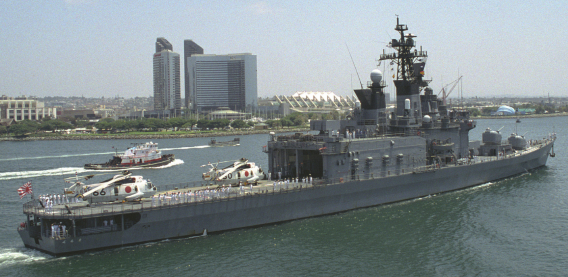 (Above and below) Two 123rd FAS HSS-2Bs sit on the stern while some the ship’s complement man
(Above and below) Two 123rd FAS HSS-2Bs sit on the stern while some the ship’s complement man
the rails of the Shirane-class destroyer Kurama as she comes into San Diego. Decommissioned in
2017, the ship had at that time sailed across the Pacific to participate in Exercise RIMPAC92.
 (Photo: U.S. National Archives/U.S. Navy PH2 M. Correa)
(Photo: U.S. National Archives/U.S. Navy PH2 M. Correa)
The 123rd seems to have enjoyed an enviable safety record. The only recorded incident occurred during takeoff and landing training at Omura AB on November 22, 1996. An engine malfunction caused SH-60J 8213 to ignominiously crash land in a carrot field near the base, but the damage sustained was minor.
 (Photo [Omura, May 1995]: Takao Kadokami)
(Photo [Omura, May 1995]: Takao Kadokami)
 (Photo [JGSDF Takayubaru, Apr. 1996]: Takao Kadokami)
(Photo [JGSDF Takayubaru, Apr. 1996]: Takao Kadokami)
 At any given time, eight aircraft would be assigned to ships and the other four in
At any given time, eight aircraft would be assigned to ships and the other four in
reserve or undergoing maintenance. (Photo taken at Tateyama, October 2002)
 In another example of sonobuoy launcher cover art, the kanji that together mean powerful flanked
In another example of sonobuoy launcher cover art, the kanji that together mean powerful flanked
the Osprey squadron marking on the aircraft at Tateyama October 2002
123rd FAS Markings
 The 123rd FAS identifier comprised the blue-yellow-blue stripes on the rear fuselage.
The 123rd FAS identifier comprised the blue-yellow-blue stripes on the rear fuselage.
(Photo [Omura, May 1990]: Takao Kadokami)
 (Photo [Omura, May 1991]: Takao Kadokami)
(Photo [Omura, May 1991]: Takao Kadokami)
Three fuselage bands: blue-yellow-blue on HSS-2s, all three blue on SH-60Js until removed around 2001.
 A pair of 123rd FAS SH-60Js airborne near Umihotaru (Sea Firefly). This man-made island marks
A pair of 123rd FAS SH-60Js airborne near Umihotaru (Sea Firefly). This man-made island marks
the start of the tunnel section of the Tokyo Bay Aqua-Line highway, which since 1997 has
connected Kawasaki in Kanagawa Prefecture with Kisarazu, Chiba Prefecture.
(Photo: JMSDF)
|
124th FAS |
Formed | Mar. 17, 1989 (21st FAW, Tateyama, HSS-2B) |
| Disbanded |
March 26, 2008 (Tateyama, merged with 122nd FAS and |
The fourth of the JMSDF’s shipborne patrol helicopter squadron, the 124th FAS added its first SH-60J (8226) alongside its complement of HSS-2Bs on April 2, 1994, soon after the fifth anniversary of its formation as a then eight-aircraft unit with 90 personnel. That November, the unit became the first to fly two types at the JMSDF Fleet Review.
The unit provided back-up by providing helicopters primarily to vessels homeported in Kure and Ohminato, in Hiroshima and Aomori prefectures, respectively.
 (Photo [2004]: aya01@長野県特地派遣隊 via Twitter @aya01flt)
(Photo [2004]: aya01@長野県特地派遣隊 via Twitter @aya01flt)
The 124th participated in three RIMPAC exercises, from March to June 1990, from May to September 1992, and from May to August 1996. It was during the last deployment that one of the unit’s aircraft was written off in a non-fatal accident, 8215’s main rotor failing and causing a fire when taxi hovering at NAS Barber’s Point, Hawaii, on June 18, 1996.
It was during the flight ban imposed, as per standard procedure, following the Barber’s Point accident that a reporter and photographer visited the 124th at Tateyama for the special feature that appeared in Japan Self Defence Squadron (sic), published by Ikaros in 1997.
At that time, including the ill-fated 8215, three aircraft had been sent to the RIMPAC 1996 exercise and another was deployed on a destroyer’s blue water voyage, so nine three-man crews were absent. (As JMSDF helicopter-capable ships would have their own maintenance crews, land-based squadron maintenance team members remained as landlubbers at their home bases.) According to the 214th’s then CO, Commander Kazuo Ozaki, elements of the unit were away for between 80 and 100 days a year, so occasions when all the members met face to face were rare. The distances between Tateyama and the flotillas that the 124th served, which would necessitate intermediate landings, plus the weather placed heavy burdens on the 124th’s personnel, as they did other units that were in the same boat. With regard to the equipment, Ozaki’s view was that although the HSS-2B had been a “self-contained aircraft”, in performing its mission as a destroyer’s sensor extension the SH-60J gave more of the impression of working in concert with the ship due to the adoption of data links. Having formerly served as CO of the 121st FAS and been in charge of flight operations aboard the destroyer Hiei, deputy CO Yūzō Enomoto also sang the praises of the improved capability in terms of the speed with which a constant stream of information could be processed by data link.
From the ground crew point of view, line maintenance chief Lt Cdr Nobori Ishida said that their lack of familiarity with the SH-60J had caused some teething problems in the first months following the type’s official entry into service.
Pins in a map of the world on a wall in the 214th’s operations building showed the ports that the Tateyama-based units had visited over the years. In August 1991, for example, the destroyer Hatsuyuki (DD-122) was carrying 124th FAS HSS-2B 8164 when accompanying the Yamayuki (DD-129) on the latter’s return visit to the ports of Southampton and Portsmouth in the UK.
Closer to home, squadron exchanges were conducted with U.S. Navy Helicopter Anti-submarine Squadron 14 (HS-14, now HSC-14), which was then flying the SH-60F Seahawk from Atsugi, in February 1996 and January 1997.
In February 1994, the unit supported the visit Emperor Akihito and Empress Michiko made to Iwo To. The couple paid their respects at the weather-beaten stone memorial dedicated to the thousands of soldiers, on both sides, who had given their lives in battle on the island 50 years before.
Having received its first SH-60J that day in April 1994, the 124th gave up the last of its HSS-2Bs and was officially reformed solely as an SH-60J squadron in March 1996—a photo of the sayonara ceremony for HSS-2B 8067 was included in the feature article.
Eventually, the 124th ceased to exist following the major reorganization of March 26, 2008, becoming one of the constituent parts of the 22nd FAS.
124th FAS SH-60Js at Omura AB, May 11, 2003
 124th FAS SH-60Js were much in evidence at the air show held at their then Omura home base in
124th FAS SH-60Js were much in evidence at the air show held at their then Omura home base in
May 2003. The last two of the above trio can be seen in these colour photos, taken when taxying
along (link) and away (link) at this very event; the lead two appear in flight again here (link).
Note that by this time the unit-identifying fuselage stripes had already
been removed. (Photo: Takao Kadokami)
 This view of 8245 being towed back to the hangar shows the way in which the main rotor blades
This view of 8245 being towed back to the hangar shows the way in which the main rotor blades
were arranged in the stowed position. For shipborne operations, the entire tail assembly could
be folded flush along the left side, as evidenced by the hinges, and the aircraft secured
not only on a beartrap device but also by deck chains attached to tie-down
points on the side of the fuselage. (Photo: Takao Kadokami)
 The SH-60J ranged next to 8245 in the hangar that day was 8221, which this photo (link) shows
The SH-60J ranged next to 8245 in the hangar that day was 8221, which this photo (link) shows
as a comparatively new recruit with the 122nd FAS at Omura in September 1993, having been
delivered in October the previous year. This aircraft was destined to end its service career
with the 124th and be placed on display at Tateyama in 2007, where it can be found to
this day; see the JMSDF Where Are They Now? page. (Photo: Takao Kadokami)
124th FAS Markings
(HSS-2B) Four blue fuselage bands of equal width, as seen at JASDF Matsushima in August 1990 (link) and in this undated photo taken at JASDF Iruma AB (link).
(SH-60J) The same fuselage bands were adorning 8245 at JASDF Hyakuri AB in October 1996, when additional markings had been applied to its left side (link).
**********************************
 (Photo taken at Iwakuni, September 2012)
(Photo taken at Iwakuni, September 2012)
TO BE CONTINUED . . .
Training squadron histories are being compiled and will form part of a fourth page.
Principal References (in Japanese unless otherwise stated)
Japan Self-Defense Force Squadron (Ikaros, September 1996)
Jieitai Kōkūki: All [Aircraft] Catalog, Kōkū Fan Illustrated No. 108
(Bunrindo, Autumn 1999)
Sikorsky SH-3 Sea King, Famous Airplanes of the World No. 15
(Bunrindo, 1989)
Watanabe, Akira, Japanese Air Arms 1952–1984, (self-published in English), 1984
Japanese aviation press, primarily various issues of Kōkū Fan
Japanese Wikipedia
Where applicable, websites of currently active JMSDF units and their bases
(All photographs on this website are copyright J-HangarSpace
unless otherwise stated.)
![]()


